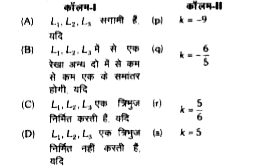यदि |(z−z1)/(z−z2)|=3 , जहाँ z1 और z2 स्थिर सम्मिश्र संख्यायें तथा z एक चर सम्मिश्र संख्या है. तब 'z' स्थित होगा
वृत्त जिसका अंतः बिन्दु 'z1' है
वृत्त जिसका अंतः बिन्दु 'z2' है
वृत्त जिसका बाह्य बिन्दु 'z1' है
वृत्त जिसका बाह्य बिन्दु 'z2' है
The correct Answer is:B, C
Step by step video, text & image solution for यदि |(z-z_1)//(z-z_2)|=3 , जहाँ z_1 और z_2 स्थिर सम्मिश्र संख्यायें तथा z एक चर सम्मिश्र संख्या है. तब 'z' स्थित होगा by Maths experts to help you in doubts & scoring excellent marks in Class 12 exams.
Updated on:21/07/2023Topper's Solved these Questions
- सम्मिश्र संख्यायेंBOOK - ERRORLESS HINDICHAPTER - सम्मिश्र संख्यायेंEXERCISE - Jee Advanced (Reasoning)
6 Videos
- सम्मिश्र संख्यायेंBOOK - ERRORLESS HINDICHAPTER - सम्मिश्र संख्यायेंEXERCISE - Jee Advanced (Comprehension)
26 Videos
- सम्मिश्र संख्यायेंBOOK - ERRORLESS HINDICHAPTER - सम्मिश्र संख्यायेंEXERCISE - Exercise
117 Videos
- समुच्चय सिद्धान्त तथा सम्बन्ध BOOK - ERRORLESS HINDICHAPTER - समुच्चय सिद्धान्त तथा सम्बन्ध EXERCISE - JEE Advanced (Reasoning type questions)
3 Videos
- सरल रेखा BOOK - ERRORLESS HINDICHAPTER - सरल रेखा EXERCISE - JEE ADVANCE (Matrix Match type questions)
4 Videos
Similar Questions
कथन-1: यदि n एक विषम पूर्णांक 3 से बडा है लेकिन 3 का गुणज नहीं है, तब (x+1)n−xn−1,x3+x2+x से विभाज्य है।
कथन-2: यदि n एक विषम पूर्णांक 3 से बड़ा है लेकिन 3 का गुणज नहीं है हम लेते हैं 1+ωn+ω2n=3
View Solutionमाना A, B, C तीन सम्मिश्र संख्याओं के समुच्चय निम्न प्रकार से परिभाषित हैं
A={z:Imz≥1}
B={z|z−2−i∣=3}
C={z:Re((1−i)z)=√2} .
तब समुच्चय A∩B∩C में अवयवों की संख्या है
View Solutionयदि z≠0 एक सम्मिश्र संख्या हो, तो
View Solutionमाना R वास्तविक संख्याओं का समुच्चय है
कथन-1 : A={(x,y)∈R×R:y−x एक पूर्णांक है} R पर एक तुल्यता संबंध है |
कथन-2 : B={(x,y)∈R×R:x=αy किसी परिमेय संख्या α के लिए} R पर एक तुल्यता संबंध है |
View Solution
View SolutionIf the vertices of an equilateral triangle are situated at z=0,z=z1andz=z2 then which of the following is(are) true? (A) |z1|=|z2| (B) |z1+z2|=|z1|+|z2| (C) |z1−z2|=|z1| (D) |argz_1-argz_2|= π3
View SolutionComplex number z1 and z2 satisfy z+¯z=2|z−1| and arg (z1−z2)=π4 . Then the value of lm(z1+z2) is
View SolutionIf ∣∣∣z1z−z2z1z+z2∣∣∣=k,(z1,z2≠0) then
View SolutionThe maximum area of the triangle formed by the complex coordinates z,z1,z2 which satisfy the relations |z−z1|=|z−z2| and ∣∣∣z−z1+z22∣∣∣≤r,where r>|z1−z2| is
View SolutionLet z1andz2 be two distinct complex numbers and let z=(1−t)z1+tz2 for some real number t with 0<t<1. If a r g(w) denotes the principal argument of a nonzero complex number w , then
|z−z1|+|z−z2|=|z1−z2| (z−z1)=(z−z2)
∣∣z−z1z−(z)1z2−z1(z)2−(z)1∣∣=0
arg(z−z1)=arg(z2−z1)
View SolutionIf z1,z2,z3,z4 are the affixes of four point in the Argand plane, z is the affix of a point such that |z−z1|=|z−z2|=|z−z3|=|z−z4| , then z1,z2,z3,z4 are
View SolutionIf z1,z2,z3,z4 are the affixes of four point in the Argand plane, z is the affix of a point such that |z−z1|=|z−z2|=|z−z3|=|z−z4| , then prove that z1,z2,z3,z4 are concyclic.
View SolutionLet z1,z2,z3∈C such that |z1|=|z2|=|z3|=|z1+z2+z3|=4.
If |z1−z2|=|z1+z3|andz2≠z3, then values of |z1+z2|⋅|z1+z3| is _____.
View SolutionIf arg z−z1z2−z1 = 0 for three distinct complex numbers z,z1,z2 then the three points are
View SolutionIf z1≠−z2 and |z1+z2|=∣∣∣1z1+1z2∣∣∣ then :
View Solution
